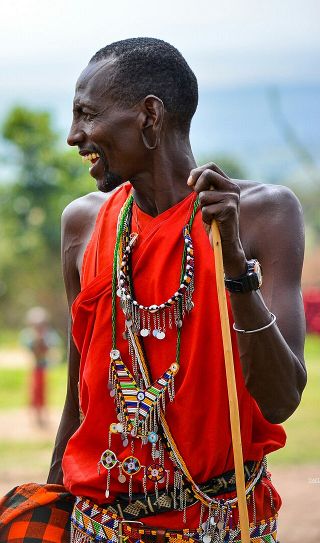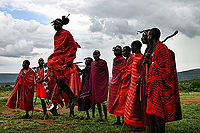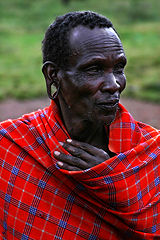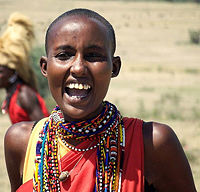Maasai
| Maasai | ||||||
|---|---|---|---|---|---|---|
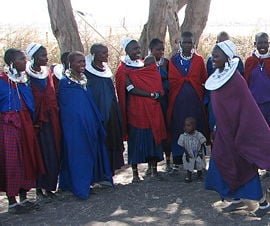
| ||||||
| Total population | ||||||
| 883,000 | ||||||
| Regions with significant populations | ||||||
| ||||||
| Languages | ||||||
| Maa (ɔl Maa) | ||||||
| Religions | ||||||
| Monotheism Christianity | ||||||
| Related ethnic groups | ||||||
| Samburu |
The Maasai are an indigenous African ethnic group of semi-nomadic people located in Kenya and northern Tanzania. Due to their distinctive customs and dress and residence near the many game parks of East Africa, they are among the most well-known African ethnic groups internationally.[3] They speak Maa,[3] a Nilo-Saharan language related to Dinka, Nuer, Turkana and Songhai. The Maasai population has been variously estimated as 377,089 from the 1989 Census[1] or as 453,000 language speakers in Kenya in 1994[2] and 430,000 in Tanzania in 1993[2] with a total estimated as "approaching 900,000"[3] Estimates of the respective Maasai populations in both countries are complicated by the remote locations of many villages, their semi-nomadic nature and their being the only ethnic group allowed free travel over the Kenyan-Tanzanian border.[citation needed]
History
According to Maasai oral history, they originated from the lower Nile valley north of Lake Turkana (southern Sudan) and began migrating south around the fifteenth century, arriving in a long trunk of land stretching from northern Kenya to central Tanzania between the seventeenth and late eighteenth century. Other ethnic groups were forcibly displaced as they settled in a long trunk of land stretching from northern Kenya to central Tanzania. [1] The Maasai territory reached its largest size in the mid-nineteenth century, and covered almost all of the Rift Valley and adjacent lands from Mount Marsabit in the north to Dodoma in the south.[4] At this time the Maasai, as well as the larger group they were part of, raided cattle as far east as the Tanga coast in Tanzania. Raiders used spears and shields, but were most feared for throwing clubs which could thrown accurately up to 70 paces. In 1852 there was a report of a concentration of 800 Maasai warriors on the move in Kenya. In 1857, after having depopulated the “Wakuafi wilderness” in southeastern Kenya, Maasai warriors threatened Mombasa on the coast of Kenya. [2] [5]
Because of this migration, the Maasai are the southernmost Nilotic speakers.
The period of expansion was followed by the Maasai "Emutai" of 1883-1902. This period was marked by epidemics of Contagious bovine pleuropneumonia, rinderpest, and small pox. The estimate first put forward by a German lieutenant in what was then northwest Tanganyika, was that 90 per cent of cattle and half of wild animals perished from rinderpest. German doctors in the same area claimed that “every second” African had a pock-marked face as the result of small pox. This period coincided with drought. Rains failed completely in 1897 and 1898. [3]
The Austrian explorer Oscar Baumann travelled in Maasailand in 1891-1893, and described the old Maasai settlement in the Ngorongoro Crater in the 1894 book “Durch Massailand zur Nilquelle” (By Massailand to the Source of Nile). "There were women wasted to skeletons from whose eyes the madness of starvation glared ... warriors scarcely able to crawl on all fours, and apathetic, languishing elders. Swarms of vultures followed them from high, awaiting their certain victims."
By one estimate two-thirds of the Maasai died during this period. [4]
In 1911, Maasai lands in Kenya were reduced by 60 percent when the British evicted them to make room for settler ranches, subsequently confining them to present-day Kajiado and Narok districts.[5] A lot of land was also taken as wildlife reserves and national parks (Amboseli, Nairobi, Maasai Mara, Samburu, Nakuru, Manyara, Ngorongoro, Serengeti and Tsavo).
Maasai are pastoralist and have resisted the urging of the Tanzanian and Kenyan governments to adopt a more sedentary lifestyle. They have demanded grazing rights to many of the national parks in both countries and routinely ignore international boundaries as they move their great cattle herds across the open savannah with the changing of the seasons. This resistance has led to a romanticizing of the Maasai way of life that paints them as living at peace with nature.
Essentially there are twelve geographic sectors of the tribe, each one having its own customs, appearance, leadership and even dialects. These subdivisions are known as the: Keekonyokie, Damat, Purko, Wuasinkishu, Siria, Laitayiok, Loitai, Kisonko, Matapato, Dalalekutuk, Loodokolani and Kaputiei.[6]
Culture
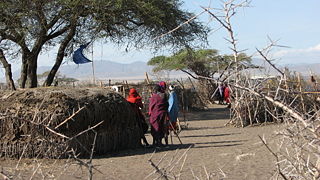
Maasai society is patriarchical in nature with the elders deciding most matters for each Maasai group. The laibon or spiritual leader acts as the liaison between the Maasai and God, named Enkai or Engai, as well as the source of Maasai herblore. The Masaai are mostly monotheistic in outlook, but many have become Christian under the influence of missionaries. Traditional Maasai lifestyle centers around their cattle which constitutes the primary source of food. They also believe that God gave them his cattle to watch over. The Tanzanian and Kenyan governments have instituted programs to encourage the Maasai to abandon their traditional semi-nomadic lifestyle and adopt an agrarian lifestyle instead.
The Maasai measure a man's wealth in terms of cattle and children rather than money - a herd of 50 cattle is respectable, and the more children the better. A man who has plenty of one but not the other is considered to be poor. [6] The Maasai believe that they own all the cattle in the world.
As a historically nomadic and then semi-nomadic people, the Maasai have traditionally relied on local, readily available materials and indigenous technology to construct their housing. The traditional Maasai house was in the first instance designed for people on the move and was thus very impermanent in nature. The Inkajijik (Maasai word for a house) are either loaf-shaped or circular, and are constructed by women. The structural framework is formed of timber poles fixed directly into the ground and interwoven with a lattice of smaller branches, which is then plastered with a mix of mud, sticks, grass, cow dung and urine, and ash. The enkaji is small, measuring about 3m x 5m and standing only 1.5m high. Within this space the family cooks, eats, sleeps, socializes and stores food, fuel and other household possessions. Small livestock are also often accommodated within the enkaji.[7][8] Villages are enclosed in a circular fence (Enkang) built by the men, usually of thorned Acacia. At night all cows and goats are placed in an enclosure in the center, safe from wild animals.
The central unit of Maasai society is the age-set. Every 15 years or so, a new and individually named generation of Morans or Il-murran (warriors) will be initiated. This involves most boys between 12 and 25, who have reached puberty and are not part of the previous age-set. Every boy must undergo the Emorata (circumcision ceremony), which is performed without anaesthetic, before he is accepted as a warrior. When a new generation of warriors is initiated, the existing ilmoran will graduate to become junior elders, who are responsible for political decisions until they in turn become senior elders. [7] [9]
Warriors are in charge of society's security while boys are responsible for herding livestock. During the drought season, both warriors and boys assume responsibility for herding livestock. The elders are directors and advisors for day-to-day activities. Women are responsible for making the houses as well as supplying water, collecting firewood, milking cattle and cooking for the family. [10]
One myth about the Maasai is that each young man is supposed to kill a lion before they are circumcised. Although lion hunting was an activity of the past, and lion hunting has been banned in East Africa, lions are still hunted when they maul Maasai livestock,[11] and young warriors who engage in traditional lion killing do not face significant consequences.[12] Increasing concern regarding lion populations has given rise to at least one program which promotes accepting compensation when a lion kills livestock, rather than hunting and killing the predator. [13] Nevertheless, killing a lion gives one great value and celebrity status in the community. Women can only marry once in a lifetime, although men may have more than one wife (if enough cows are owned, they may have more than one at a time).
Young girls undergo Female genital cutting (FGC) in an elaborate rite of passage ritual in which they are given instructions and advice pertaining to their new role, as they are then said to have come of age and become women, ready for marriage. These circumcisions are usually performed by a hired local expert without anaesthetic using crude knives, glass or other sharp implements available for as much as US $6.00 per girl. Girls are married off early, sometimes as young as seven years old.
The practice of FGC draws a great deal of criticism from both abroad and many women who have undergone it, and in some cases has recently been replaced by a "Cutting with words" ceremony involving singing and dancing in place of the mutilation. However, the practice remains deeply ingrained and valued by the culture, as well as being held as necessary, since Maasai men typically reject any woman who has not undergone it as either not marriageable or worthy of a much-reduced bride price. [8] FGC is illegal in both Kenya and Tanzania. [14][15]
Challenges and hope in the 21st century
Due to influence from other cultures (mostly western), the traditional Maasai way of life is increasingly threatened. Over the years, many projects have begun to help Maasai tribal leaders find ways to preserve their traditions while also balancing the education needs of their children for the modern world. The emerging forms of employment among the Maasai people include farming, business (selling of traditional medicine,running of restaurants/shops, buying and selling of minerals, selling milk and milk products by women, embroideries), and wage employment (as security guards/ watchmen, waiters, tourist guides), and others who are engaged in the public and private sectors.[16]
Body modification
The piercing and stretching of earlobes has been common among the Maasai.
The removal of deciduous canine tooth buds in early childhood is a practice that has been documented in the Maasai of Kenya and Tanzania. There exists a strong belief among the Maasai that diarrhoea, vomiting and other febrile illnesses of early childhood are caused by the gingival swelling over the canine region, and which is thought to contain 'worms' or 'nylon' teeth. This belief and practice is not unique to the Maasai. In rural Kenya a group of 95 children aged between six months and two years were examined in 1991/92. 87% were found to have undergone the removal of one or more deciduous canine tooth buds. In an older age group (3-7 years of age), 72% of the 111 children examined exhibited missing mandibular or maxillary deciduous canines. diagram [17] [18]
Diet
Traditionally, the Maasai diet consisted of meat, milk, and blood from cattle. However, the inclusion of blood in the traditional diet is waning due to the reduction of livestock numbers. More recently, the Maasai have grown dependent on food produced in other areas such as maize meal, rice, potatoes, cabbage (known to the Maasai as goat leaves), etc. The Maasai who live near crop farmers have engaged in cultivation as their primary mode of subsistence. In these areas, plot sizes are generally not large enough to accommodate herds of animals; thus the Maasai are forced to farm. [19]
Clothing
Red is a favored colour among the Maasai. Many Maasai in Tanzania wear simple sandals, sometimes soled with pieces of motorcycle tires. Both men and women wear wooden bracelets. The Maasai women regularly weave and bead jewellery. This bead work plays an essential part in the ornamentation of their body.
See also
ReferencesISBN links support NWE through referral fees
- ↑ 1.0 1.1 Kenya - Population Distribution rcbowen.com, '1989 Census, ... Kenya Factbook, 15th Edition, 1997-1998. Kul Bhushan, Newspread International'
- ↑ 2.0 2.1 2.2 Ethnologue report for language code:mas ethnologue.com, '453,000 in Kenya (1994 I. Larsen BTL) ... 430,000 in Tanzania (1993)', Gordon, Raymond G., Jr. (ed.), 2005. Ethnologue: Languages of the World, Fifteenth edition. Dallas, Tex.: SIL International
- ↑ 3.0 3.1 3.2 Maasai - Introduction Jens Fincke, 2000-2003
- ↑ Northern Tanzania with Kilimanjaro and Zanzibar by Phillip Briggs 2006 page 200 ISBN -10: 1 84162 146 3
- ↑ Sources and Methods in African History: Spoken, Written, Unearthed By Toyin Falola, Christian Jennings Published 2003 Boydell & Brewer ISBN 1580461344 page 18 2
- ↑ Northern Tanzania with Kilimanjaro and Zanzibar by Phillip Briggs 2006 page 200 ISBN -10: 1 84162 146 3
- ↑ Northern Tanzania - The Bradt Safari Guide by Phillip Briggs 2006 British Library ISBN-10:1 84162 146 3
- ↑ Razor's Edge - The Controversy of Female Genital Mutilation IRIN Humanitarian News and Analysis, UN Office for the Coordination of Humanitarian Affairs March 2005, accessed May 14, 2007
External links
- Network of Change Organization for Maasai
- Maasai communication/info exchange - NOC Community
- Massailand Informative Webseite about the Massai people, also help to self-help with supporting of Projects.
- Volunteer to help with projects in Maasailand - Kenya
- Maasai Development Project. An organisation which helps the Maasai people.
- An Administrative Survey of the Masai Social System 1939
- An all Maasai Organization
- Maasai People of Africa
- Maasai Language Project
- Maasai Environmental Resource Coalition
- Maasai history culture song images
Photographs
- Photos of Maasai Mara & Maasai People (Photo gallery available with descriptions)
- Africa on the Matrix: The Maasai (photographs and information)
- Photographs of Kenya peoples, including Maasai (photographs and information)
- Photographs in Maasai Village (photographs)
Credits
New World Encyclopedia writers and editors rewrote and completed the Wikipedia article in accordance with New World Encyclopedia standards. This article abides by terms of the Creative Commons CC-by-sa 3.0 License (CC-by-sa), which may be used and disseminated with proper attribution. Credit is due under the terms of this license that can reference both the New World Encyclopedia contributors and the selfless volunteer contributors of the Wikimedia Foundation. To cite this article click here for a list of acceptable citing formats.The history of earlier contributions by wikipedians is accessible to researchers here:
The history of this article since it was imported to New World Encyclopedia:
Note: Some restrictions may apply to use of individual images which are separately licensed.
